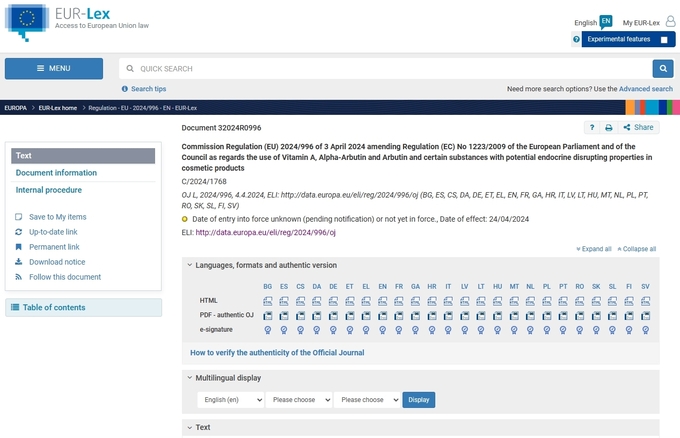
[코스인코리아닷컴 이효진 기자] EU 집행위원회는 지난 3일 9가지 화장품 성분에 대한 EU 화장품 규정(CPR) 부록 개정 규정을 EU 공식 저널에 게재했다. 이번 규정은 공식 저널에 게재된 후 20일째 되는 날부터 발효된다.
개정된 규정을 보면, 우선 UV filter 4-methylbenzylidene camphor가 화장품 규정(CPR) 부록II에 추가되어 화장품 사용이 금지된다. EU 공동체 시장 출시는 2025년 5월 1일까지 가능하며 시중 공급 기한은 2026년 5월 1일까지다.
화장품 규정(CPR) 부록III에 추가되는 화장품 성분은 6가지다. genistein은 화장품에 최대 0.007% 농도로 사용할 수 있다. 시장 출시는 2025년 2월 1일까지 가능하고 시중 공급 기한은 2025년 11월 1일이다.
daidzein은 화장품에 최대 0.02% 농도로 사용할 수 있다. 시장 출시는 2025년 2월 1일까지 가능하고 시중 공급 기한은 2025년 11월 1일이다.
kojic acid는 얼굴과 손 화장품에 최대 1% 농도로 사용할 수 있다. 시장 출시는 2025년 2월 1일까지 가능하고 시중 공급 기한은 2025년 11월 1일이다.
retinol, retinyl acetate, retinyl palmitate는 바디 로션에 최대 0.05%, 기타 leave-on 및 rinse-off 제품은 최대 0.3%의 레티놀당량(RE) 농도까지 사용할 수 있다. 이러한 화장품에는 '비타민A 함유, 사용 전 일일 사용량을 고려하세요'라는 경고 문구를 반드시 표시해야 한다. 시장 출시는 2025년 11월 1일까지 가능하고 시중 공급 기한은 2027년 5월 1일이다.
alpha arbutin은 페이스 크림에 최대 2%, 바디 로션에 최대 0.5%의 농도로 사용할 수 있다. alpha arbutin을 함유한 제형에서 Hydroquinone 수치는 가능한 한 낮게 유지돼야 하며 불가피한 미량 수준보다 높지 않아야 한다. 시장 출시는 2025년 2월 1일까지 이고 시중 공급 기한은 2025년 11월 1일이다.
arbutin은 최대 농도 7%까지 페이스 크림에 사용할 수 있다. Arbutin을 함유한 제형에서 Hydroquinone 수치는 가능한 한 낮게 유지돼야 하며 불가피한 미량 수준보다 높지 않아야 한다. 시장 출시는 2025년 2월 1일까지 이고 시중 공급 기한은 2025년 11월 1일이다.
화장품 규정(CPR) 부록V에서는 Triclocarban 등 2가지 성분의 함량을 새롭게 규정했다. Triclocarban은 구강 청결제를 제외한 모든 화장품에 최대 0.2% 농도로 사용할 수 있다. 순도 기준은 3,3',4,4'-tetrachloroazobenzene ≤ 1ppm, 3,3',4,4'- tetrachloroazoxybenzene ≤ 1ppm이다. 이 성분은 만 6세 미만 어린이용 치약에는 사용할 수 없으며 triclocarban이 함유된 치약에는 '만 6세 미만 어린이에게 사용하지 마세요'라는 경고 문구를 표시해야 한다.
Triclosan은 치약, 핸드워시, 바디워시, 샤워젤, 데오도란트(스프레이가 아닌 제품), 페이스 파우더와 잡티 컨실러, 인공 네일 장치 적용 전 손톱과 발톱 세척용 네일 제품에 최대 0.3%의 농도로 사용할 수 있다. 이 성분은 만 3세 미만 어린이용 치약에는 사용할 수 없으며 triclosan이 함유된 치약에는 '만 3세 미만 어린이에게 사용하지 마세요'라는 경고 문구를 표시해야 한다. 시장 출시는 2024년 12월 31일까지이고 시중 공급 기한은 2025년 10월 31일이다.
■ EU 화장품 규정(CPR) 부록 개정 규정 원문
EU Regulation on 9 Cosmetic Ingredients Published (Includes Vit A)
On 3 April 2024, the EU Commission published on the Official Journal of the EU the regulation amending the Annexes to the EU Cosmetic Products Regulation (CPR) with 9 cosmetic ingredients. This regulation will enter into force on the twentieth day following that of its publication in the Official Journal of the European Union. Below is a summary of the updates.
UV filter 4-methylbenzylidene camphor is added to Annex II of the CPR, and therefore banned for use in cosmetic products. The ‘placing on the market’ deadline is 1 May 2025; the ‘making available’ (off-shelf) deadline is 1 May 2026.
The following ingredients are added to Annex III.
genistein can be used in cosmetic products at a maximum concentration of 0.007%. The ‘placing on the market’ deadline is 1 February 2025; the ‘making available’ (off-shelf) deadline is 1 November 2025.
daidzein can be used in cosmetic products at a maximum concentration of 0.02%. The ‘placing on the market’ deadline is 1 February 2025; the ‘making available’ (off-shelf) deadline is 1 November 2025.
kojic acid can be used in face and hand cosmetic products at a maximum concentration of 1%. The ‘placing on the market’ deadline is 1 February 2025; the ‘making available’ (off-shelf ) deadline is 1 November 2025.
retinol, retinyl acetate, retinyl palmitate can be used in body lotions at a maximum concentration of retinol equivalent (RE) of 0.05%, and other leave-on and rinse-off products at a maximum concentration of RE of 0.3%. These cosmetic products must be labelled with the warning ‘Contains Vitamin A. Consider your daily intake before use.’. The ‘placing on the market’ deadline is 1 November 2025; the ‘making available’ (off-shelf) deadline is 1 May 2027.
alpha arbutin can be used in face cream at a maximum concentration of 2%, and body lotion at a maximum concentration of 0.5%. Hydroquinone levels shall remain as low as possible in formulations containing alpha- arbutin and shall not be higher than the unavoidable trace level. The ‘placing on the market’ deadline is 1 February 2025; the ‘making available’ (off-shelf) deadline is 1 November 2025.
arbutin can be used in face cream at a maximum concentration 7%. Hydroquinone levels shall remain as low as possible in formulations containing arbutin and shall not be higher than the unavoidable trace level. The ‘placing on the market’ deadline is 1 February 2025; the ‘making available’ (off-shelf) deadline is 1 November 2025.
The following ingredients are amended in Annex V.
Triclocarban can be used in all cosmetic products with the exception of mouthwash at a maximum concentration of 0.2%. Purity criteria: 3,3',4,4'-tetrachloroazobenzene ≤ 1 ppm, 3,3',4,4'-tetrachloroazoxybenzene ≤ 1 ppm. This ingredient cannot to be used in toothpaste intended for children under 6 years of age; therefore, toothpaste containing triclocarban must have the following warning ‘Not to be used for children under 6 years of age’.
Triclosan can be used in toothpastes, hand soaps, body soaps/shower gels, deodorants (non-spray), face powders and blemish concealers, nail products for cleaning the fingernails and toenails before the application of artificial nail systems at a maximum concentration of 0.3%. This ingredient cannot to be used in toothpaste intended for children under 3 years of age; therefore, toothpaste containing triclocarban must have the following warning ‘Not to be used for children under 3 years of age’. The ‘placing on the market’ deadline is 31 December 2024; the ‘making available’ (off-shelf ) deadline is 31 October 2025
Copyright ⓒ Since 2012 COS'IN. All Right Reserved.
#코스인 #코스인코리아닷컴 #화장품 #코스메틱 #EU집행위원회 #EU화장품규정(CPR) #부록개정규정 #EU공식저널게재 #9가지화장품성분 #함량규제 #UV filter 4-methylbenzylidene camphor #사용금지 #genistein #최대0.007%사용 #daidzein #최대0.02%사용 #kojic acid #최대1%사용